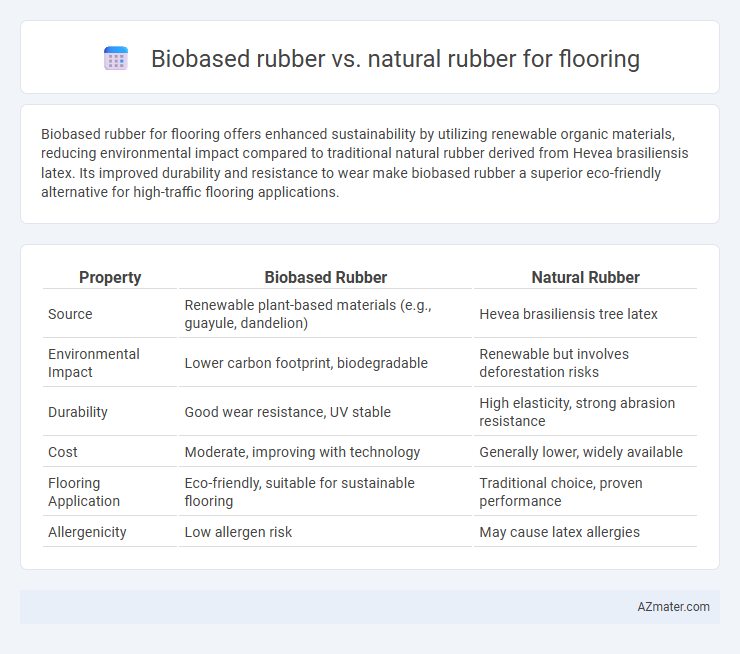Biobased rubber for flooring offers enhanced sustainability by utilizing renewable organic materials, reducing environmental impact compared to traditional natural rubber derived from Hevea brasiliensis latex. Its improved durability and resistance to wear make biobased rubber a superior eco-friendly alternative for high-traffic flooring applications.
Table of Comparison
| Property | Biobased Rubber | Natural Rubber |
|---|---|---|
| Source | Renewable plant-based materials (e.g., guayule, dandelion) | Hevea brasiliensis tree latex |
| Environmental Impact | Lower carbon footprint, biodegradable | Renewable but involves deforestation risks |
| Durability | Good wear resistance, UV stable | High elasticity, strong abrasion resistance |
| Cost | Moderate, improving with technology | Generally lower, widely available |
| Flooring Application | Eco-friendly, suitable for sustainable flooring | Traditional choice, proven performance |
| Allergenicity | Low allergen risk | May cause latex allergies |
Introduction to Biobased Rubber and Natural Rubber
Biobased rubber is derived from renewable plant sources, offering an eco-friendly alternative to traditional natural rubber, which is harvested from Hevea brasiliensis trees. Both materials provide excellent elasticity and durability, making them suitable for resilient flooring applications. Biobased rubber enhances sustainability by reducing reliance on fossil fuels while maintaining comparable performance characteristics to natural rubber.
Sourcing and Sustainability of Rubber Materials
Biobased rubber for flooring is primarily derived from renewable plant sources such as guayule or dandelion, offering a sustainable alternative to traditional natural rubber which is extracted from the latex of Hevea brasiliensis trees. Natural rubber sourcing often leads to deforestation and biodiversity loss due to expanding rubber plantations, whereas biobased rubber reduces environmental impact by utilizing non-food crops and agricultural by-products. Sustainability in flooring materials strongly favors biobased rubber as it supports circular economy principles with lower carbon footprints and enhanced biodegradability compared to conventional natural rubber.
Manufacturing Processes: Biobased vs. Natural Rubber
Biobased rubber manufacturing involves the polymerization of renewable monomers derived from plant sources, reducing reliance on traditional natural rubber tapped from Hevea brasiliensis trees. Natural rubber undergoes coagulation and drying processes directly from latex extracted from rubber trees, with more variability in raw material quality due to environmental factors. Biobased rubber production offers more consistent properties and scalability through controlled synthetic routes compared to the agricultural dependency of natural rubber.
Environmental Impact and Carbon Footprint
Biobased rubber for flooring significantly reduces environmental impact by utilizing renewable resources and minimizing reliance on petroleum-based materials, leading to a lower carbon footprint compared to traditional natural rubber. Natural rubber production involves deforestation and high water usage, contributing to greenhouse gas emissions and habitat loss, whereas biobased alternatives often optimize sustainable agricultural practices and waste valorization. Lifecycle assessments indicate that biobased rubber flooring materials offer enhanced carbon sequestration potential and reduced overall emissions, supporting greener building certifications and eco-friendly construction goals.
Physical Properties and Performance Comparison
Biobased rubber displays enhanced durability and abrasion resistance compared to traditional natural rubber, making it a superior choice for high-traffic flooring applications. It offers improved tensile strength and elasticity while maintaining environmental sustainability through renewable raw materials. Natural rubber provides excellent cushioning and resilience but may degrade faster under UV exposure and chemical contact, limiting its lifespan in commercial flooring.
Health and Safety Considerations in Flooring
Biobased rubber flooring offers enhanced health and safety benefits compared to natural rubber by reducing exposure to volatile organic compounds (VOCs) and allergens, resulting in improved indoor air quality. Its hypoallergenic properties minimize the risk of respiratory issues and skin irritation, crucial for sensitive environments like schools and healthcare facilities. Both types provide durable, slip-resistant surfaces, but biobased rubber's lower chemical emissions make it a safer choice for long-term occupant health.
Cost Analysis and Market Availability
Biobased rubber offers a competitive cost advantage over natural rubber due to scalable synthetic production methods reducing raw material expenses, making it increasingly attractive for flooring applications. Market availability of biobased rubber is expanding rapidly with advancements in sustainable materials and growing demand for eco-friendly alternatives, while natural rubber supply remains subject to volatility from agricultural fluctuations and geopolitical factors. Cost analysis shows biobased rubber flooring provides long-term price stability and better resistance to market disruptions compared to traditional natural rubber flooring options.
Durability and Lifespan in Flooring Applications
Biobased rubber flooring offers enhanced durability due to its improved resistance to wear, UV exposure, and chemical degradation compared to natural rubber, extending its functional lifespan in high-traffic areas. Natural rubber provides excellent elasticity and shock absorption but tends to degrade faster under prolonged moisture and sunlight exposure, limiting its longevity. When selecting flooring materials, biobased rubber demonstrates superior lifespan performance, reducing maintenance frequency and replacement costs in commercial and industrial applications.
Design Flexibility and Aesthetic Options
Biobased rubber offers enhanced design flexibility for flooring due to its customizable formulation, allowing for a broader range of colors, textures, and finishes compared to traditional natural rubber. Its ability to integrate with advanced manufacturing techniques such as 3D printing provides architects and designers increased aesthetic control and innovation potential. While natural rubber maintains resilience and durability, biobased alternatives excel in adapting to diverse visual and functional flooring requirements without compromising environmental benefits.
Future Outlook for Rubber Flooring Innovations
Biobased rubber, derived from sustainable plant sources, offers a promising future for rubber flooring by reducing environmental impact and enhancing biodegradability compared to traditional natural rubber. Innovations in biobased rubber formulations aim to improve durability, elasticity, and resistance to wear, aligning with green building standards and consumer demand for eco-friendly materials. Advancements in bioengineering and materials science are expected to drive cost reductions and performance enhancements, positioning biobased rubber as a viable, high-performance alternative in the flooring industry.

Infographic: Biobased rubber vs Natural rubber for Flooring
 azmater.com
azmater.com